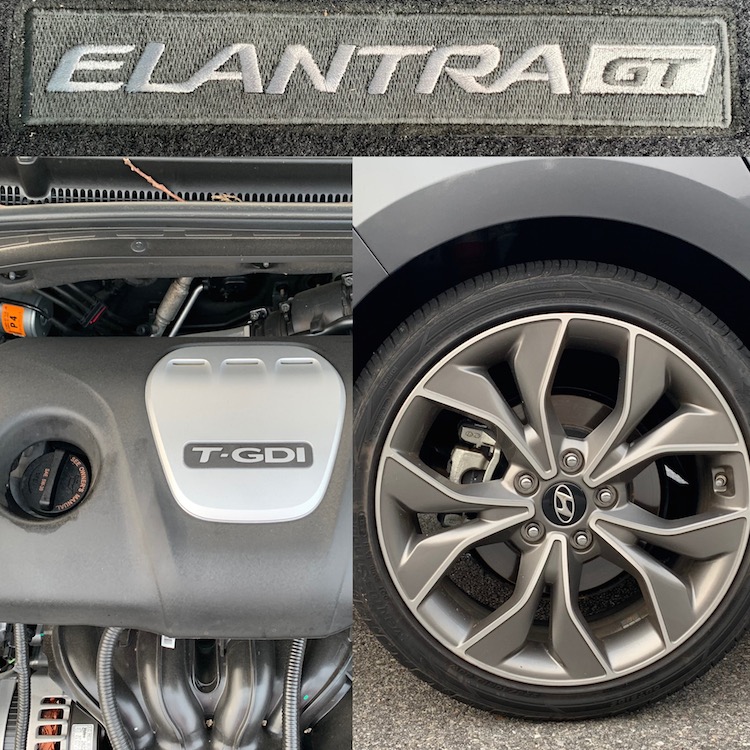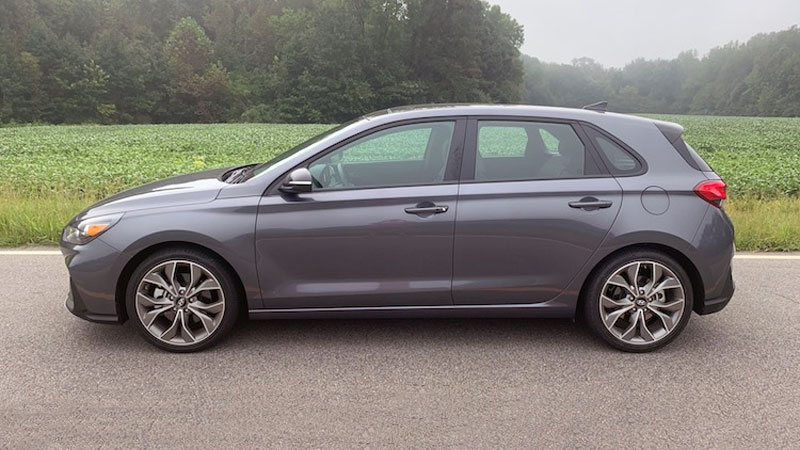N Line performance comes to Hyundai.
Hyundai offers the compact Elantra in sedan and hatchback body styles, the latter known as the Elantra GT. For 2019, the first “N Line” model arrives, this one serving as the top trim for the GT.
The N Line replaces the GT Sport, but it represents much more than a name change. Indeed, this particular model benefits from stiffer engine and transmission mounts, taut springs, enhanced steering and shocks tuning, and new front and rear sway bars.
Ultimately, when you hear “N Line” you should know that it represents the entry-level style and performance category for Hyundai’s wider N performance line. Models denoted with just an “N” supply maximum power, something we’re seeing in the all-new Veloster.
It is doubtful we’ll witness an Elantra GT N, but the N Line offers its own design and performance characteristics, which we’ll explore as we discuss the model at hand.
2019 Hyundai Elantra GT N Line Review
Hyundai offers the standard Elantra GT ($20,450), the N Line with a manual transmission ($23,300), and the N Line with a dual-clutch automatic transmission ($24,400). This front-wheel-drive five-door hatchback holds five.
The Elantra GT competes with the Mazda 3, Volkswagen Golf, and the Honda Civic. In particular, the Golf STi and Civic Si are the nearest competitors to the N Line.
N Line Design
If the Hyundai Elantra GT N Line evokes a reminder of the Volkswagen GTi, that’s on purpose. Its silhouette is sporty, with pulled-in corners and a lowered stance. A bold mesh grille, large air intakes, sleek LED lighting elements, crisp lines, beautiful 18-inch alloy wheels, and a rear diffuser with dual exhaust, mark this model.
Subtle design elements, including black side mirrors and black beltline trim, are also evident. There’s nothing “budget” about the N Line, rather there’s a quiet sophistication that should appeal to a certain breed of shoppers.
Inside, the N Line verve continues with its N Sport, bolstered bucket seats. They’re leather-trimmed with contrasting red dual stitching. The steering wheel and shifter are wrapped in leather, but that sliding armrest is covered in imitation leather. Hyundai did a remarkable job with making it feel like the real thing, however.

Two large dials occupy the instrument panel. To the left is the tachometer. Set within it is a smaller gas readout. To the right is the speedometer. And set within that is the fuel gauge.
Smack in the middle is a digital driver’s information center. A layered dashboard, a sporty steering wheel (no flat bottom!), metal pedals, and red trim surrounding the vents are among the more fetching visual cues present.
Practically speaking, the N Line is very comfortable for two, manageable for four, and very tight for five. Back seat legroom is lacking, which is typical of the segment. Figure that most owners buy this car for their ride and fold down the rear seat for long trips away from home.
In doing so, you’re rewarded with 55.1 cubic feet of storage space, up from the standard 24.9 cubic feet.
On the Road

The power under the hood is one thing. How any car ultimately handles is what makes all the difference.
With the N Line, Hyundai swapped out its torsion-beam rear suspension for a multi-link setup, which combined with its rigid body and balanced chassis, enables this hatch to cut up corners and stay planted on the road. Steering is light, yet accurate. Torque steer barely registers and when it rears itself, it isn’t the distraction it might be on other models.
The 1.6-liter turbo-four makes for a proper match for the little hatchback. The turbo spools up quickly and with authority. Our test model had the 7-speed dual-clutch transmission, which is an upgrade from the 6-speed manual gearbox.
We relished the idea of driving with the manual but made do with the automatic and the steering-wheel-mounted paddle shifters. In any case, your 0-to-60 mph time should approach 6 seconds, which is laudable.
With lots of twisty roads ahead of us, we sought them out with glee. The N Line did not disappoint as it pushed its way into every curve and pulled out again without any negative drama. In fact, except for the most angled curves, we didn’t have to release the gas pedal — the N Line stayed within the lines.
There are a few points to keep in mind about the engine. It certainly is capable, but it is quieter than what we’d expect. Further, the exhaust doesn’t burble and toot to the extent we’d want. Perhaps Hyundai wanted to make a distinction between N Line and N models — we haven’t tested the latter yet, however.
What we’d like to see from Hyundai is available all-wheel drive, especially in a model to take on the “no longer offered in the U.S.” Ford Focus RS.
We know Hyundai has been testing an i30 N in Europe (the i30 is another name for the Elantra) and that move would elevate Hyundai’s performance brand to also take on the VW Golf R. We think this will happen, perhaps in Veloster guise, which would give Hyundai a level of performance excitement we haven’t seen since the Genesis Coupe.
Auto Trends Recommends
If you’re shopping the Elantra GT and want a performance edge, then the N Line is worth a look.
Our N Line tester retailed for nearly $30,000 as it included the dual-clutch transmission and the Tech Package ($3,850). That package bundles such items as a panoramic sunroof, navigation, ventilated front seats, a premium audio system, wireless charging pad, and expanded driver-assist features, including adaptive cruise control with full stop and go.
Importantly, the N Line adds many of the tuner features enthusiasts want. That said, the aftermarket parts industry has an assortment of electronics, fuel delivery and exhaust systems, and kits to stir your heart.
And with Ford, Chevy, and Dodge cutting back or retreating from the segment, Hyundai offers a compelling hatchback to replace your old ride.
2019 Hyundai Elantra GT N Line Specifications
| Hyundai | 2019 Elantra GT N Line |
|---|---|
| Segment | Compact Hatchback |
| Price Range | $23,300 or $24,400 |
| Destination Charge | $930 |
| Standard Engine | 1.6-liter, turbo I4 |
| Horsepower | 201 @ 6000 |
| Torque (lb.-ft.) | 195 @ 1500~4500 |
| Transmission | 6-speed manual; 7-speed DCT |
| Seating | 5 |
| Curb Weight (pounds) | 3,014 to 3,155 |
| Wheelbase (inches) | 104.3 |
| Length (inches) | 170.9 |
| Width (inches) | 70.7 |
| Height (inches) | 57.7 |
| Headroom (f,r…inches) | 39.1; 38.5 |
| Legroom (f,r…inches) | 42.2; 34.8 |
| Shoulder room (f,r…inches) | 56.2; 55.4 |
| Hip room (f,r…inches) | TBD |
| Storage (cubic feet) | 24.9; 55.1 |
| Gross vehicle weight (pounds) | 4,079 |
| Towing (pounds) | NR |
| Payload (pounds) | NR |
| Fuel | Regular |
| Fuel Tank (gallons) | 14.0 |
| EPA Fuel MPG (city/highway/combined) | 25/32/27 |
| Manufacturing Plant | Montgomery, Alabama |
Data compiled by Tom Keegan. Specifications supplied by the manufacturer.
See Also – Compact Delight: 2018 Hyundai Elantra GT
Photos copyright Auto Trends Magazine. All rights reserved.
- 2024 Mazda CX-50: A Compact SUV with Premium Aspirations - Apr 15, 2024
- 2024 Ford Mustang (Iconic Pony Car Evolves) - Apr 4, 2024
- 2024 Ford Maverick (Looks Like a Truck, Drives Like a Car) - Mar 28, 2024


